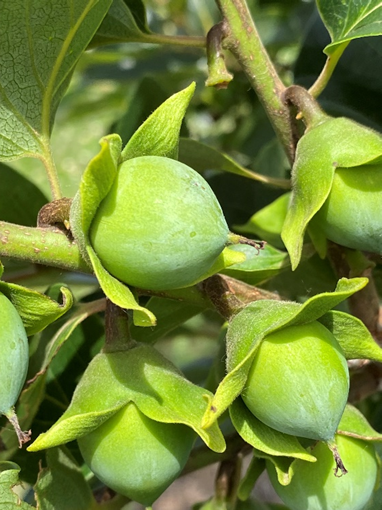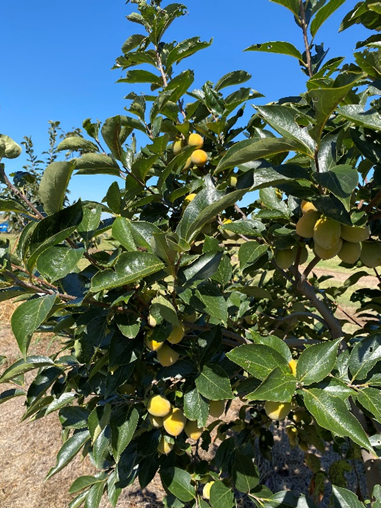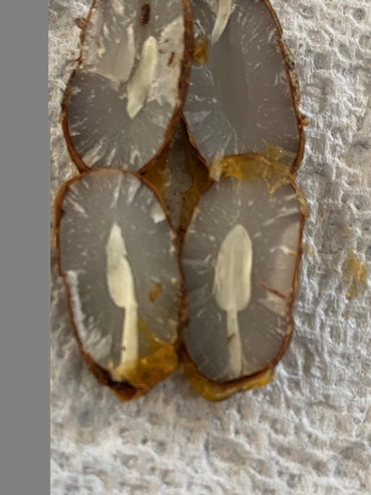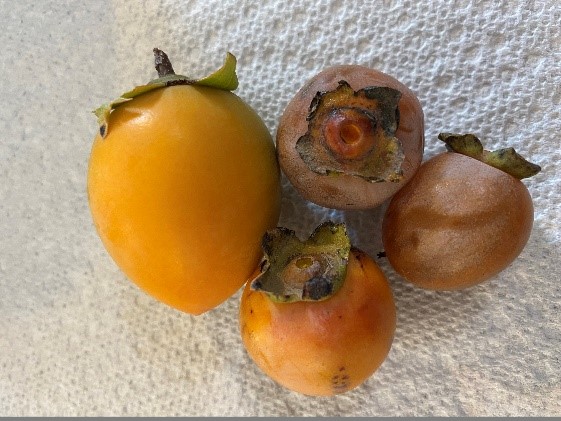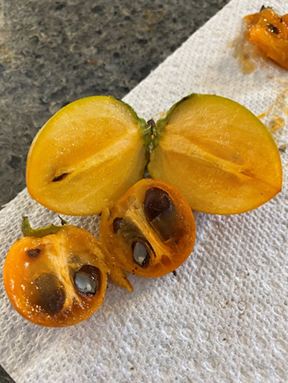October 2024 Hort Tips
Tuesday, October 1, 2024
The Magic of Autumn
David Hillock
I remember as a kid growing up in Iowa the awesome fall colors of the many maples, ashes, oaks and other species common to the area. We would rake the leaves up into big piles and then play in them for hours. It was even legal back then to burn your leaves and roast marshmallows and hotdogs over the fire (now-a-days it is prohibited in most communities). Much of Oklahoma can also have spectacular fall displays. But what causes those green leaves to turn colors in the fall?
The green in leaves is chlorophyll, which is responsible for catching the sun’s energy and converting it into energy for plant growth. During the summer the chlorophyll is high and masks other pigments in the leaf. When fall approaches the chlorophyll declines and the other pigments shine through. Pigments that are present include anthocyanins, which are purple and red, and carotenoids and tannins which provide yellow, orange, and brown hues.
Weather conditions play a vital role in our fall colors. Ideal weather conditions that lead to the spectacular fall colors are bright sunny days and cool nights. Prolonged warm spells in the fall and cloudy rainy weather can lead to poor fall color. Dryer soils in fall, but not drought conditions, also lead to brighter fall colors.
Fall is an excellent time to plant trees and shrubs. It is also a good time to select plants for their fall color. Some plants are selected for vivid fall colors and propagated in a way that the fall color is consistent from year to year, if weather conditions cooperate. Some species are grown from seed, so genetics provides widely variable fall color from plant to plant. For example, Caddo sugar maple and Chinese pistache grown from seed will provide an array of fall color from yellow-green to vivid orange and red. For species such as these, observing them in the garden center in the fall allows you to select the colors you are interested in.
Fall is a Good Time to Plant
David Hillock
Now is an excellent time to plant most trees and shrubs as well as other landscape plants such as perennials and cool-season annuals. Cooler temperatures reduce stress to allow ideal root growth and establishment before cold weather. In fact, roots continue to grow as long as soil temperatures are above 40 degrees F. Plants installed during the growing season are susceptible to high transpiration rates leading to drying of plant tissues.
Research suggests that early fall planting is best for container-grown and B&B shade and ornamental trees and pines, but spring is best for planting bare-root plants and broadleaf evergreens, such as holly and Southern magnolia. However, many containerized plants can be planted at any time if handled properly. Be sure to water regularly to keep roots and soil moist. A light mulch would also be in order around plants.
Planting pansies along with spring flowering bulbs will not only add to the spring display, but can provide a needed color during those cool, sometimes dreary fall and winter months. Pansies are extremely cold hardy and will tolerate snow and ice.
After properly preparing the bed area, pansy transplants can be set out at the recommended spacing with spring flowering bulbs scattered throughout. It won’t matter too much if they are spaced close together because the spring bulbs will poke right up through the pansy foliage. This arrangement creates another dimension to the garden; the pansies form an “understory” of color, while the spring bulbs form an “upperstory” of color. Often the colors of pansy and spring flowering bulbs provide striking complementary color combinations making the spring bed come alive.
Success for a cool-season annual planting is dependent, however, on bed preparation and location. A sunny to partly shady location with excellent drainage is ideal and will encourage the most blooming. A heavily shaded spot will result in smaller, fewer flowers and may never dry out, which could result in root rots. On the other hand, do not let the plants become too dry. Cold, dry winter winds with little moisture in the form of rain or snow will result in winter scorch. Be sure to water the landscape enough to wet the soil to a depth of about 6 - 8 inches.
Additional cool-weather-loving annuals that can be planted this time of year are ornamental cabbage and kale, snapdragons, and others.
Young trees with green or tender bark should be wrapped by late October. Remember to start wrapping from the ground up to the first major limb.
Advantages of tree wraps for young plants:
- Deter animals from browsing on bark.
- Reflects sun that either scalds the trunks or makes them susceptible to southwest injury during the winter months (bark is warmed followed by a sudden plunge in temperature which kills that portion of the bark).
Do not apply any more fertilizer to trees or shrubs. By refraining from fertilizer applications, woody plants can harden off their latest growth to avoid freeze injury. Likewise, pruning should be discontinued at least until dormancy occurs. Otherwise, new succulent growth could be damaged as temperatures drop below freezing.
Dwarf Columnar European Hornbeam (Carpinus betulus 'Columnaris Nana')
Casey Hentges, Associate Extension Specialist
Bailey Singleton, Extension Assistant
There are two species of Hornbeam that do well in Oklahoma and are actually Oklahoma Proven Trees – Carpinus caroliniana, the American Hornbeam and Carpinus betulus, the European Hornbeam.
American hornbeam is a slow-growing, understory tree with an attractive globular form. It typically grows 20-35' tall.
The European hornbeam grows in full sun to part shade and needs little pruning when grown as a tree. However, it responds well to hard pruning and is often grown as a hedge in Europe. If left unpruned it is a medium-sized, tree that grows 40-60’ tall with a pyramidal to oval-rounded crown.
Hornbeams are commonly referred to as musclewood and get that name for the smooth muscle-like characteristic of the mature trunks and branches that are an extremely hard wood that was used to make bowls and tools.
The cultivar ‘Fastigiata’ is popular to use around buildings and tighter spaces because it is more upright and columnar.
Dwarf Columnar European Hornbeams, Carpinus betulus ‘Columnaris Nana’ are great for smaller spaces because they top out at a height around 10 feet and width of about 2-4 feet. They can be used strategically to divide areas like a screen in a garden or backyard. Just like the larger forms of hornbeams, these do not require any pruning to maintain the tight columnar form. They also have a dense branch structure which offers safe shelter for small animals.
These dwarf hornbeams are best suited for zones 5-8 so here in Oklahoma is right in the sweet spot for cold hardiness. They have a rough textured leaf that is dark green in the summertime and then will turn yellow later in fall. In the winter, after dropping the leaves, they have larger than normal buds that will again push out new leaves the following spring.
Whichever hornbeam you may choose to try, any of them would make a great addition to your landscape.
Top 5 Columnar Trees Youtube Video.
Plant a Persimmon Tree for an Easy to Grow Fruit Tree
Becky Carroll, Senior Extension Specialist
Common persimmons (Diospyros virginiana) are found growing in the Eastern half of Oklahoma. They are slower growing medium-sized trees found along creeks, pastures, roadsides, and are easy to spot this time of year. The lovely orange fruits are starting to turn from green to orange and are very visible on a heavy bearing tree. But don’t let the color change fool you. They are not ripe until later in the fall. If you have ever been asked to try a green persimmon, you won’t go back for another. Persimmons are astringent fruits and unless fully ripened and soft (look almost overripe and wrinkling), they are not edible to humans or the wildlife that love them. Eating a green persimmon is best described as “removing all the moisture from your mouth and leaves you puckering up!” The tannins in green fruit are bitter and astringent and should not be eaten. As the fruit ripens, the tannins decrease as sugars increase. Many people believe a frost or freeze is needed to ripen persimmon. That is an old wives tale, but normally ripening time falls in this late fall timeframe. Persimmons can vary in flavor, size, and ripening time.
They have shiny large leaves that make a pretty landscape tree. One thing to remember about common persimmon is that they are dioecious. They have male and female trees on separate trees so you’ll need one of each to have fruit production. They bloom in the spring with lovely yellow blossoms. The trees are drought tolerant and well adapted to most Oklahoma landscapes.
Many wildlife use the persimmon as a food source. Deer, birds, raccoons, skunks, opossums, and squirrels all enjoy eating the fruit. Some people use the fruit to predict the upcoming winter conditions. Cutting through the local seeds (or use pliers to split the seed) to expose the embryo to see the shape – if it shows a spoon – big snows that winter; fork – mild winter; a knife predicts harsh winter with cutting cold temperatures. This year, the persimmons showed knives and a large spoon. We will see if we have a harsh winter with lots of snow! Actually, I think the right one looks more like a pie server! Wonder what that means for us?
You can purchase select native persimmons that have been chosen for superior quality and size. Some recommended types are Prok, H63A.
Japanese persimmons (Diospyros kaki) have low chilling requirements and can be cold sensitive. They are usually much larger and non-astringent. Fuyu and Eureka are a couple of common varieties.
Crosses/hybrids are available of the D. virginiana and kaki types that produce larger fruit with good quality. Nikita’s gift and Sofie’s gift are two hybrids that are recommended by a local nurseryman. The Cimarron Valley Research station has hybrids JT-02 Mikkusu and David’s Kandy Corn plus select native Jon’s Pride and Prok 3. They were planted in 2021, and this is the first year for flowering and fruiting. You can also use local trees for rootstock. Need help locating specific cultivars, reach out and I’ll share some resources.
The top fruit is a hybrid cultivar named David’s Kandy Corn. The smaller fruits are common persimmons found in Lincoln County on 26 Sept 24. Some of the native fruits are softening and dropping.
Propagating Southern Magnolia Seeds
David Hillock
The Southern Magnolia, Magnolia grandiflora, has lustrous dark green foliage; large, creamy white and beautifully fragrant flowers, which are followed by the rose-red aggregate fruit that splits open in the fall revealing a bright red seed. It is this seed that probably sparks the curiosity of many a gardener to try their hand at propagation. Some of the advantages of raising magnolias from seed are:
- It is cheaper than raising them by vegetative means.
- It generally gives fast establishment and good growth.
- It produces a vigorous root system.
A disadvantage is that they generally take longer to flower than vegetatively raised plants. They may also not be true-to-type, or in other words, will have different characteristics from the parent plant due to open pollination.
Magnolia seeds are gathered in the fall as soon as possible after the fruit is ripe, when the red seeds are visible all over the fruit. The outer seed coat, red fleshy pulp, must be removed before the seed is stratified. Soak the seed for one or two days in warm or hot water to which a detergent has been added to remove any remaining traces of the oily film which protects them from drying out. Separation of good, well-filled seeds from the empty ones can be easily accomplished while they are still in water. The good seeds (without the red pulp) sink, while the empty seeds and the pulp float. After cleaning, the seeds should either be sown immediately in the fall or prior to spring planting, stratified for two to three months at about 40°F.
If you plan to sow them now, in the fall, this can be done two ways. Either by sowing them directly into the soil in a well-prepared spot in the garden or by sowing them thinly in a seed tray or similar container filled with a well-drained potting medium. Water the seeds. Place the labeled and dated seed tray in a cold frame where the seed will be exposed to low temperatures. As this system is not controlled, germination of some seed may be delayed for a season.
A more controlled method is done by mixing the seed with moist sand or peat moss, placing it into a container and storing in a place where temperatures will be maintained at 40°F. The readiness of the seed to germinate is marked by the splitting of the inner seed coat.
Allowing the seeds to dry out at any time seems to be harmful. After sowing, the germination medium must not become dry. Southern magnolia seeds, and perhaps those of other species, lose their viability if stored through the winter at room temperature. If prolonged storage is necessary, the seeds should be held in sealed containers at 32 to 40°F. After the seed has gone through the stratification period, it can be sown in the same way as mentioned previously and placed where temperatures are about 70°F. Germination will take place in about 30 to 40 days. Magnolia seedlings grow rapidly, and generally are large enough to transplant by the end of the first season. Transplanting should be kept at a minimum, since this retards the plants.
(Sources: Plant Propagation Principles and Practices, by Hartmann, Kester, & Davies, 5th edition, pg. 585, Prentice Hall; Magnolias, by J. M. Gardiner, pg. 23, 24, The Globe Pequot Press; Propagation of Trees and Shrubs by Seed, revised by Campbell & Mitchell, Hort 4, Oklahoma Gardening information sheet).
Raking Basics
David Hillock
Fall is soon upon us, and it is time to begin thinking about what you will do with all those leaves. Just bagging them and letting them go to the landfill is a waste of our tax dollars and a valuable garden resource. Instead of bagging them and hauling them off to the dump this year consider these suggestions.
Use as a Mulch
An easy way to get rid of leaves is to simply rake them into landscape beds as nice winter mulch. Some say that leaves may suffocate your plants but use your good judgment. Small leaves generally will not offer any threat, but huge leaves, such as sycamore, might. This leaf litter has also been proven to provide an important habitat for beneficial insects that need a place to hibernate through the winter.
Compost Them
If you have too many leaves to rake into your garden beds you can compost the rest. Place them in the compost pile along with other garden plant material. You don’t need a special compost bin to accomplish this process. A big hole dug in the back corner of the yard, or some other inconspicuous place works nicely. Fill the hole with lots of leaves and other garden plant material.
Mow 'Em
This is the method I like to use after I have raked the majority into landscape or wooded areas around my property. I simply mow over them as often as necessary before they build up too deep. The chopped leaves return valuable organic matter and nutrients to the soil. If you use a mower with a bag attachment you can capture the chopped leaves and then distribute them as needed. They work well as an excellent mulch, compost fodder, or can be worked into your vegetable garden.
Leaf Power
If you have tons of leaves, you may consider buying or renting a vacuum-shredder. This is more effective than just blowing them around with a blower. Vacuum-shredders suck up the leaves, chop them, and then collect them into a bag. Use as described above. Remember, however, that shredders, blowers, and choppers work well only when the leaves are nice and dry. If they're too wet, they'll just clog.
Back to Nature
If you own a wooded area or large property where you can dispose of leaves, go for it. However, remember that too many leaves can suffocate existing plants, so spread them out a bit.
Time to Collect & Enter Pecans for the 2024 State Pecan Show
Becky Carroll
It won’t be long until pecan growers will be collecting the crop for 2024. Harvest is quickly approaching, shucks are splitting, orchard floors are being groomed, and equipment is being serviced. From visiting with people around the state, it seems like we will have a good crop this year. Samples can be from commercial growers, hobbyists, or homeowners.
Don’t get too busy that you forget to set aside some of your best pecans to enter the Oklahoma State Pecan Show. Entry numbers have been low for the last few years. Send in your samples to compete for Best in Show!
If you’d like to learn more about the Oklahoma State Pecan show and how to submit a winning sample, view the Pecan Topics for November 2020 webinar has a presentation.
If no county/area show is available, growers may enter pecans directly by sending samples to:
Cimarron Valley Research Station
Attn: Becky Carroll
10820 South Jardot
Perkins, OK 74059
Samples should arrive by January 24, 2025.
Samples should be entered in a sealed plastic or paper bag. Label the bag on the outside and place a label inside the bag. Information should include exhibitors name and address, county, and type of pecan entered. Be sure to follow the guidelines that are listed below before sending entries.
A few helpful hints: Take the time to select pecans that are all the same cultivar, or same size and shape natives – don’t send mixed pecans (they will be disqualified). Select uniform, clean, uncracked pecans. Presentation can make the difference between two very similar samples. Make sure to send 2 pounds of pecans in a labeled and sealed bag.
General Rules and Guidelines
- All entries must be grown in Oklahoma during the current season.
- Each entry shall consist of two pounds of nuts.
- Entries deemed unworthy by the judges will not compete for awards.
- Label each entry as to exhibitor’s name, address and cultivar of nuts. If more than one native (seedling) pecan exhibit is made, identify the nuts from separate trees by numbers. Only one exhibit of each cultivar or native tree may be entered by one individual.
- Each entry will compete in one of the following 26 classes:
- Barton
- Burkett
- Cheyenne
- Choctaw
- Comanche
- Gratex
- Kanza
- Kiowa
- Lakota
- Maramec
- Mohawk
- Nacono
- Oconee
- Pawnee
- Peruque
- Podsednik
- Schley (eastern)
- Shoshoni
- Squirrels Delight
- Stuart
- Waco
- Western
- Wichita
- Other Cultivars
- Large Native (seedling) 60 nuts/lb or larger
- Small Native (seedling) more than 60 nuts/lb
- Each grower is allowed to participate at one county show of his or her choice.
- Each grower is allowed to enter one entry in each show class with the exception of Class 24 (Other Cultivars), Class 25 (Large native) and Class 26 (Small native)
- Each grower may enter one entry from each native (seedling) tree.
- Entries should be shipped or mailed to arrive at the show at least one day prior to the deadline.
- County pecan shows will not be affected by these rules and procedures.
- Samples will be placed in cold storage and judged prior to the Oklahoma Pecan Growers Annual Meeting. At that time, the winning entries will be displayed with awards and recognitions. All entries will become the property of the OPGA.
- First, second, and third place winners in each class at the State Pecan Show will receive ribbons.
- State Pecan Show Special Awards – Plaques will be awarded for the largest pecan entry, the entry having the highest kernel percentage, the champion native, and the best entry of the show. The plaques are presented at the Award luncheon during the annual meeting.
- If a qualifying show is not available, growers may submit entries in accordance with these guidelines directly to the State Show. Entries in the state show must be received by January 24, 2025.
Please reach out with any questions – becky.carroll@okstate.edu.


